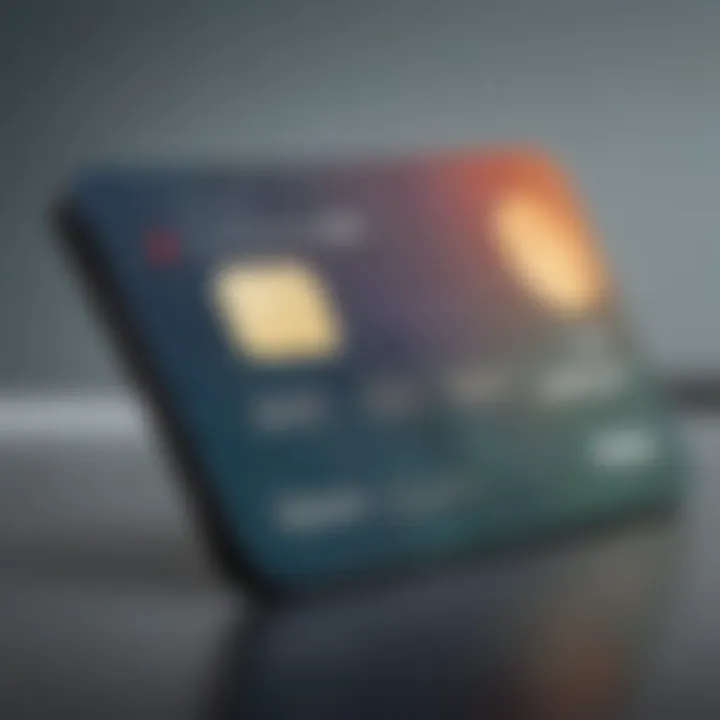A Thorough Analysis of Debit Cards and Their Impact


Intro
Understanding the intricacies of debit cards offers a doorway into the larger conversation surrounding personal finance, banking, and spending habits. With their roots nestled firmly in the modern financial ecosystem, debit cards have emerged as a staple for consumers, transcending traditional cash transactions. Not simply pieces of plastic, these cards embody a wide array of benefits, challenges, and, importantly, innovations that steer the way we manage our finances today.
As we embark on this exploration, the multitude of diverse factors at play will become evident. These range from the basic mechanics of how debit cards function, including transaction efficiency, to the vital consumer protections they afford. After all, in an era when digital banking dominates, being savvy with your financial tools has never been more crucial.
In a world where every cent counts, knowing the nuances of debit card features can vastly improve one's personal finance management. Additionally, examining how these cards differ from their credit counterparts will prepare you for smarter spending decisions.
This article aims to be a comprehensive guide, aiming to unpack not just the characteristics of debit cards themselves, but the context in which they operate and the evolving landscape of financial regulations that shape their functionality. So, whether you’re an investor, a student of finance, or an everyday consumer, prepare to delve into the multifaceted world of debit cards and emerge more informed.
Investment Dictionaries
Understanding Key Terms
In order to fully grasp the importance of debit cards in personal finance, it’s essential to familiarize ourselves with a few key terms:
- Debit Card: A payment card that deducts money directly from a consumer's checking account to pay for a purchase.
- PIN (Personal Identification Number): A numeric password that allows access to the debit card account when making transactions.
- ATM (Automated Teller Machine): A machine that allows individuals to access their bank accounts, typically for cash withdrawals.
- EMV: A global standard for cards equipped with computer chips and the technology used to authenticate chip-card transactions.
Having a solid understanding of these terms will empower readers. It equips you with the language necessary to navigate discussions about financial products and services.
Financial Product Reviews
In-Depth Analysis of Investment Products
As debit cards are pivotal in managing daily expenses, they play a crucial role in larger investment strategies as well. It's imperative to know how certain debit card features can intersect with your financial ambitions. For instance, many debit cards now offer features such as:
- Cashback Rewards: These allow cardholders to earn back a percentage of the money spent using their debit card.
- Budgeting Tools: Some debit card providers integrate budgeting features to help track expenditures.
- No Overdraft Fees: Unlike credit cards, debit cards often prevent users from spending beyond their existing balance, helping to avoid debt.
Comparative Ratings and Evaluations
When choosing the right debit card, it’s worthwhile to consider various providers and the unique features they offer. A few factors to look into include:
- Fees: Some cards may charge transaction fees, withdrawal fees, or monthly maintenance fees.
- Security Measures: Look for cards that provide fraud protection and lost card reporting features.
- International Use: Evaluate the fees and exchange rates for using the card abroad, if that applies to you.
Ultimately, the right debit card aligns with your personal financial strategy, empowers your spending habits, and may contribute to your long-term financial comfort.
"Understanding the features and limitations of debit cards is like having a sturdy map in the unfamiliar terrain of finance. It not only guides your path but helps avoid pitfalls along the way."
With these foundational elements laid out, the journey into the world of debit cards continues, preparing readers for nuanced decisions that can significantly impact their financial well-being.
Understanding Debit Cards
In the ever-evolving landscape of personal finance, understanding debit cards is crucial. These tools are embedded in the financial lives of many individuals worldwide. They provide a way to access one’s funds without the complexities that credit can bring. Grasping the nuances of debit cards can empower consumers to make knowledgeable choices that align with their financial routines.
Definition and Basics
A debit card is a payment card that allows a cardholder to make purchases utilizing their bank account funds. When a transaction occurs, money directly transfers from the cardholder's checking account to the vendor's account without involving credit. This simplicity is one of the main attractions for users seeking to manage their spending in real-time.
Essentially, debit cards serve several important functions:
- Direct Access to Funds: They provide immediate access to the balance in a user’s bank account.
- Withdrawal Capability: They allow for cash withdrawals at ATMs, presenting a convenient way to carry cash when needed.
- Transaction Records: Debit cards often come with transaction histories, which can help with budgeting efforts and tracking expenses.
The Evolution of Debit Cards
The journey of debit cards is fascinating. They’ve transformed from early paper checks to plastic cards now standard in wallets. The late 20th century saw the rise of these cards as they were linked directly to consumer checking accounts, offering a means to avoid carrying cash. Examples abound across various countries, such as the Switch in the UK and Maestro, which were among the first to link directly to bank accounts.
Over the years, as technology advanced, debit cards evolved with features such as chip technology and contactless payments. This transition made transactions not just simpler, but also safer. As a result, debit cards became a preferred choice for those who did not want to incur debt or manage a credit card’s interest rates and fees.
How Debit Cards Work
The mechanics behind debit cards are relatively straightforward. When you use a debit card, whether at a store or online, you are authorizing a transfer of funds directly from your bank account. Here’s a brief rundown of the steps involved:
- Card Swipe or Entry: You either swipe the card at a POS terminal or enter card details online.
- Authorization: The merchant’s system contacts your bank to verify that you have sufficient funds.
- Transaction Approval or Rejection: If approved, the transaction will proceed; if not, it may be rejected due to insufficient funds or other issues.
- Fund Transfer: Finally, the funds are deducted from your checking account and sent to the merchant.
Debit cards can also include added features such as PIN protection, which prevents unauthorized access to your funds. This security layer is crucial, especially as the online marketplace expands rapidly. However, users must always be vigilant about their financial data to protect against fraud.
"Understanding how debit cards function is essential for making informed decisions about spending and saving in today's financial ecosystem."
Understanding these fundamental aspects of debit cards lays the groundwork for deeper discussions on various types, benefits, and challenges associated with them.
Types of Debit Cards
When it comes to managing personal finances, the types of debit cards available play a pivotal role. Understanding these variations can empower consumers to choose the model that best suits their needs. Each type of debit card offers its unique features, benefits, and some drawbacks that users must consider. This section aims to dissect the major categories of debit cards, helping readers navigate this diverse landscape.
Standard Debit Cards
Standard debit cards are the backbone of modern-day transactions for many individuals. These cards are directly linked to a checking account, which means every purchase you make comes directly out of that account, typically leaving no room for overspending. This characteristic promotes a disciplined approach to personal finances, as users are often more aware of their spending limits.
One primary advantage of standard debit cards is their straightforward nature. You can usually use them anywhere that accepts card payments, both in-store and online. Additionally, there are usually no monthly fees associated with these cards, making them an economical option for day-to-day banking.


However, it’s essential to stay vigilant with standard debit cards. While they provide ease of use and accessibility, there is limited protection against overdrafting. Without proper management, one may find themselves in a sticky financial situation.
Prepaid Debit Cards
Prepaid debit cards have gained traction, especially among individuals who might not have access to a traditional bank account. These cards require upfront funding, allowing users to load a specific amount of money that they can then spend until depleted.
This prepaid nature offers a level of financial control not always found in standard debit cards. For instance, parents often use prepaid cards to manage their children’s spending. By loading a fixed sum, it allows kids to learn money management without risking going overboard. Furthermore, many prepaid debit cards do not require a credit check, making them accessible to a wider demographic.
However, some prepaid cards can come with hidden fees. For instance, loading money onto the card or withdrawing cash from ATMs may incur charges. Consequently, thorough research is necessary to avoid drowning in unexpected costs.
Rewards Debit Cards
For those who seek to benefit even more from their spending, rewards debit cards present an enticing option. These cards provide incentives such as points, cash back, or travel rewards for every purchase made. The allure of earning rewards on everyday expenditures can transform mundane shopping sprees into opportunities for bonuses.
Interestingly, the rewards program might differ considerably from card to card. For instance, some cards might offer higher cash back rates for grocery shopping, while others might shine in dining categories. This flexibility allows consumers to choose cards that resonate with their spending habits.
Yet, it's worth noting that rewards debit cards often come with monthly maintenance fees. These costs can erode the advantages gained from the reward points, thus necessitating a careful balance between spending, rewards, and fees.
In examining the types of debit cards available, it's clear that each form has its unique appeal. Understanding the nuances can lead to better financial decisions.
With these insights, readers can better navigate their choices, taking into account personal needs and financial goals. A well-chosen debit card can help lay the foundation for financial health and responsible spending.
Advantages of Using Debit Cards
Using debit cards comes with an array of benefits that cater to a wide spectrum of users, from everyday consumers to savvy financial managers. This section explores why debit cards are frequently preferred, especially when it comes to personal finance. The distinct features of debit cards make them integral for managing day-to-day financial needs. In the context of this article, understanding these advantages allows consumers to make informed decisions about leveraging debit cards effectively.
Financial Control and Budgeting
Perhaps the strongest selling point of debit cards is the control they provide over personal finances. Unlike credit cards, which can encourage overspending due to their nature of borrowing, debit cards connect directly to a user's bank account. Thus, they allow users to spend only what is available in their accounts. This encourages more mindful spending, reducing the temptation to splash out impulsively.
Consider a scenario where a user has a monthly budget of $500 for groceries. Using a debit card ensures that once they hit that limit, further purchases are a thing of the past, unless they decide to deposit more funds. This naturally fosters responsible budgeting habits. In this way, debit cards serve as a practical tool for those keen on maintaining financial health.
- Transparency in Spending: Most banking apps offer transaction history, providing clear insight into spending patterns.
- Avoiding Debt: Without the risk of accumulating credit card debt, users face less financial strain in the long run.
Reduced Risk of Debt
The reduction of debt risk stands as another compelling advantage of debit cards. In a world where financial emergencies often breed dependence on credit, debit cards present a welcome alternative. Users can rest easy knowing that any charges to their card are limited to their existing balance, thus virtually eliminating the chance of generating outstanding debt.
This is particularly important for younger users or those new to managing finances. They can engage in transactions with confidence, without the looming fear of interest charges that creep up with traditional credit cards.
"While credit cards can riddle you with debt, debit cards keep your feet on the ground."
- Easier Financial Recovery: In tough financial times, it’s easier to navigate bills and payments without debt accumulation weighing one down.
- Simplicity in Loan Management: With less debt overhead, users can better focus on future investments like savings accounts or retirement plans.
Convenience and Accessibility
Convenience is king in today's fast-paced environment, and debit cards truly shine in this area. They offer a seamless way to access funds, whether through direct purchases or ATM withdrawals. This sort of accessibility transforms the act of spending into a frictionless experience.
Consider the case of someone traveling to a new city. By utilizing a debit card, they can manage their finances simply by withdrawing cash or using the card at various retailers. Furthermore, many shops and services now embrace contactless payment methods tied to debit cards, streamlining the checkout process even more.
- Wide Acceptance: Debit cards are widely accepted, making them a reliable payment method across various platforms.
- Online Transactions: With growth in e-commerce, having a debit card simplifies online shopping without requiring a credit line.
In summary, the advantages of using debit cards lay the groundwork for practical financial management. They not only help users maintain balance in their spending, but they also offer peace of mind against debt. As we delve deeper into the realm of debit cards, it becomes evident that the benefits extend beyond mere convenience, crafting a comprehensive view of personal finance that resonates with today's consumer.
Challenges Associated with Debit Cards
The convenience of debit cards brings with it a set of challenges that cannot be overlooked. While these financial tools offer a range of benefits, users must remain aware of potential pitfalls that could lead to unwanted expenses or limitations. Understanding and addressing these challenges allows consumers to use debit cards more effectively to manage their finances.
Fees and Charges
Debit cards can come with an array of fees that may not be immediately apparent. Users can encounter charges such as ATM fees, monthly maintenance fees, and overdraft fees. For instance, some banks impose fees when you withdraw cash from an out-of-network ATM. This can be particularly frustrating when you find yourself facing unexpected charges just to access your own money.
Additionally, maintenance fees often sneak into the fine print. Some debit cards charge a monthly fee unless certain conditions are met, like maintaining a specified balance or making a minimum number of transactions. If an account isn't actively managed, it can snowball into unnecessary charges that chip away at your balance. Being a wise shopper means carefully examining the terms and conditions before committing.
Paying attention to these fees can help in maintaining financial health. It’s advisable to regularly check statements and account policies, so you can avoid any surprises. Always compare offerings from different financial institutions to find the most cost-effective options, as savings can add up over time.
Limited Fraud Protection
Fraud cases can happen to anyone, and debit cards often come with less protective measures compared to credit cards. Most debit cards are tied directly to a checking account, meaning that unauthorized transactions can immediately affect your funds. Unlike credit cards, which have more robust consumer protections under federal law, debit card users may find their options more limited when dealing with fraud.
The speed at which fraud can impact one's bank account makes it crucial to monitor your transactions closely. A fraudulent transaction can wipe out available funds in an instant, leaving one scrambling to cover expenses or pay bills. Plus, the process of disputing fraudulent charges can be cumbersome, often requiring the consumer to prove that they did not authorize the transaction.
In scenarios where fraud does occur, it can take time for money to be reimbursed. Be mindful of using strong passwords and enabling transaction notifications on your debit card account. Taking a proactive stance against potential fraud can help safeguard your finances in this fast-paced digital world.
Potential for Overdrafting
The risk of overdrafting is another significant challenge debit cardholders face. Many debit cards come with overdraft protection, which can lead users to spend more than what’s available in their checking account. This can create a false sense of security, encouraging overspending.
Imagine making a purchase that pushes your account to its limits. If overdraft protection is enabled, the transaction may still go through, but you'll be slapped with an overdraft fee – which could be as steep as thirty-five dollars or more. Overdrafting not only incurs these fees but also creates a situation where controlling spending becomes difficult. It can spiral into a cycle of fees that add pressure to one's financial stability.


Some consumers may not even realize they’ve gone over until they receive notification from their bank. To mitigate this risk, individuals need to stay vigilant about their account balances. Setting up alerts for low balances can help anticipate potential overdraft situations before they escalate.
By being aware of the limitations that debit cards can impose, consumers can take charge of their finances. Each challenge presents an opportunity for better management and financial literacy in the long run. As users navigate the landscape of debit cards, making informed decisions can mitigate risks and enhance overall experience.
Debit Card Security Features
In a world where financial transactions are part and parcel of daily life, security features on debit cards cannot be taken lightly. They serve as a formidable barrier against fraud and theft, guarding personal finances. Given the increasing reliance on digital transactions, it is crucial to understand what makes debit card usage secure.
Chip Technology
The introduction of chip technology marked a significant leap in debit card security. Unlike traditional magnetic strips, which can easily be duplicated, chip cards contain a microprocessor that generates a unique transaction code for each purchase. This means that even if a criminal manages to steal your card, they can’t simply replicate it to make transactions. Chip cards make it exceedingly difficult for fraudsters to commit unauthorized transactions, adding a reliable layer of protection.
In many regions, retailers have been transitioning to chip-enabled terminals, enhancing security even further. Shoppers may witness, or even become accustomed to, inserting their card into a reader as part of the payment process—a small inconvenience that provides significant benefits.
Fraud Monitoring Systems
Another line of defense lies within fraud monitoring systems. Most banks employ sophisticated algorithms that analyze transaction patterns, flagging anything that appears out of the norm. For instance, if someone usually uses their debit card locally and a sudden purchase is made halfway across the globe, the transaction might be blocked or flagged for additional verification.
"Banks leverage technology that acts as a watchful guardian, attempting to identify and combat suspicious activity."
Moreover, many financial institutions provide customers with real-time alerts through texts or emails every time a transaction is made, allowing for immediate reporting should something seem amiss. But it’s worth noting that these systems are not flawless; they rely heavily on distinguishing comment patterns and thus may occasionally raise alerts that are mere false alarms.
User Authentication Methods
User authentication methods are also paramount in ensuring security. The most common form is the Personal Identification Number (PIN). It's a simple number that complements the physical card, and most banks encourage choosing something unique rather than easily guessable numbers like birthdays.
However, the evolving landscape has prompted banks to explore other authentication mechanisms, like biometric scanning. Fingerprint scanners or facial recognition technology can be found on some newer phones, underscoring the trend toward advanced methods of verifying identity. These methods offer an extra layer of security that traditional PINs cannot match.
Selecting a debit card that provides multiple authentication options can enhance personal security. As technologies develop, consumers may find themselves choosing cards equipped with features that were unimaginable just a decade ago.
Comparing Debit Cards and Credit Cards
Examining the differences between debit cards and credit cards is crucial for consumers as these two financial tools often serve varying purposes. Both options have their own sets of features, benefits, and potential pitfalls that can significantly influence a user's financial health. Understanding how they relate can empower individuals to select the right instrument for their needs, thereby optimizing their personal finance strategy.
Financial Impact
The financial implications of using debit versus credit cannot be overstated. When it comes to debit cards, users are limited to their available funds. This provides a level of control, keeping overspending at bay. For instance, if you have $500 in your account, that’s the maximum you can spend. This lack of borrowing can help prevent debt accumulation, which might be appealing to those wary of overextending themselves.
On the flip side, credit cards allow for spending beyond one's current financial means, often leading to convenience and flexibility, but with a catch. Users are often charged interest on unpaid balances, which can spiral out of control if not carefully managed. For example, someone traveling can benefit from a credit card, enjoying the perks like travel insurance and rewards points, yet they run the risk of racking up debt if they do not prioritize repayment.
Usage Scenarios
Different scenarios can lend themselves to one card type over the other. With debit, it shines when individuals want to maintain strict budgeting habits. Family outings, groceries, or everyday expenses can be managed effectively, as the card only permits spending within the money they already possess.
Credit cards, however, shine in scenarios requiring larger purchases or emergencies. Imagine needing to book an emergency flight due to a family situation; paying with a credit card can be lifesaving. Furthermore, they often come with added benefits that debit cards may lack, such as purchase protection and rewards systems that can yield points for future travel or shopping.
Consider another example: starting a new business. An entrepreneur may find it beneficial to use credit to establish a line of credit, which can bolster their credit score over time if managed well. However, relying solely on credit can lead to potential hiccups if income is sporadic.
Consumer Preferences
When it comes to preferences, personal attitudes about debt play a pivotal role. Some folks prefer the comfort of knowing they can’t spend above their means, making debit a practical choice. On the other hand, many people appreciate the benefits credit cards can provide, such as cashback rewards or travel points.
Demographics also contribute to preference trends. Younger generations, for instance, may lean towards using debit cards due to their straightforward nature. In contrast, older folks might favor credit cards, having learned to navigate them responsibly over the years. Meanwhile, individuals looking to improve their credit score typically prefer credit, as it directly impacts their financial history.
"Navigating the choice between debit and credit is like choosing between driving a car and riding a bike. Each has its own benefits and drawbacks, depending on the route you’re taking."
In summary, the debate between debit and credit cards is multifaceted, and understanding the specific financial impacts, usage scenarios, and consumer preferences can guide one’s decisions effectively. Whether aiming for better financial management or seeking maximum benefits from purchases, both card types have their rightful place in the financial toolbox.
Recent Trends in the Debit Card Market
The debit card market is undergoing rapid changes, reflecting broader shifts in consumer behavior, technology, and financial practices. Recognizing recent trends helps investors, financial advisors, and even students of finance understand how debit cards are adapting to meet modern needs. It highlights the dynamic nature of the financial landscape and the continued relevance of debit cards for daily transactions.
Digital Wallet Integration
One of the most notable trends in the debit card market is the seamless integration of digital wallets. Services like Apple Pay, Google Pay, and Samsung Pay have surged in popularity, allowing users to link their debit cards directly to their smartphones. This shift simplifies payment processes, enabling transactions with a simple tap of a phone, thus appealing greatly to consumers looking for convenience.
This integration also means that businesses are increasingly adopting contactless payment technologies, reducing transaction times and enhancing customer satisfaction. The implications for security are significant as well; most digital wallets use encryption and tokenization, offering an added layer of protection compared to traditional card usage. However, this raises questions about privacy and data security, as more personal information becomes stored online.
Emergence of Cryptodebit Cards
As the world grows more tech-savvy, the emergence of cryptodebit cards is garnering attention. These cards allow users to spend cryptocurrency as easily as cash, bridging the gap between digital currencies and everyday purchases. They offer a new dimension to spending, especially in regions where traditional banking access is limited.
Though in their infancy, cryptodebit cards provide an exciting opportunity to revolutionize how people interact with their finances. Users can hold a variety of cryptocurrencies while making transactions in fiat currency, essentially democratizing access to digital money. Investors and entrepreneurs interested in this space should keenly follow these developments, as the market potential is vast. There are also risks involved, such as fluctuating values of cryptocurrencies and regulatory uncertainties that could influence how these cards operate.
Contactless Payment Technology
Contactless payment technology is not just a buzzword; it’s changing the way consumers engage in commerce. Debit cards equipped with Near Field Communication (NFC) chips allow users to make payments by simply tapping their card on point-of-sale terminals. This technology enhances speed and efficiency during transactions, and it comes with the added benefit of being hygienic, a factor that has become increasingly important post-pandemic.
Nonetheless, this growing trend prompts discussions concerning security. While many card issuers promote contactless payments as secure, some consumers remain wary of potential fraud or unauthorized charges. Therefore, educating consumers on how to use contactless debit cards safely while promoting the benefits is essential for the continued growth of this technology.


As the debit card market continues to evolve, staying informed about these trends can empower consumers and investors alike to make wise financial decisions.
In summary, the trends shaping the debit card market hold significant implications for both users and industry players. From digital wallet integration and cryptodebit cards to contactless payments, these elements showcase how the financial landscape is adapting to new technologies and consumer preferences. It’s not just about shifting from cash to card; it’s about redefining how we perceive and interact with our money on a day-to-day basis.
Regulatory Aspects of Debit Cards
Understanding the regulatory landscape surrounding debit cards is crucial for both consumers and financial service providers. These regulations not only govern the operations of debit card issuers but also protect consumer rights and ensure fair practices within the industry. As debit cards continue to evolve in response to technological advancements and changing market dynamics, staying abreast of these regulations becomes increasingly important.
In this section, we’ll dig into two significant components: consumer protection legislation and compliance requirements for issuers. Together, these facets create a framework that supports safe and responsible usage of debit cards within the financial ecosystem.
Consumer Protection Legislation
Consumer protection legislation serves as a safety net for users of debit cards. It aims to provide a legal foundation that safeguards consumers against fraud and unfair practices. In many places, laws like the Electronic Fund Transfer Act (EFTA) play a vital role in establishing user rights concerning electronic card transactions. This legislation outlines key provisions, such as:
- Disclosure Requirements: Issuers must clearly communicate fees, terms, and conditions associated with the use of debit cards. This transparency helps consumers make informed choices.
- Error Resolution Rights: If a consumer reports an unauthorized transaction, they must be allowed to contest it. The law stipulates that consumers should not be liable for more than a certain amount when reporting fraudulent activity in a timely manner.
- Limitations on Liability: In instances where users report lost or stolen cards, the liability for unauthorized transactions is capped, providing consumers added assurance.
This legal framework serves not only as protection for individuals but also fosters trust in the financial system. It assures consumers that their interests are being defended, leading to greater usage of debit cards and encouraging financial inclusion.
"Regulatory frameworks lay the groundwork for a secure financial environment, ultimately empowering consumers in their transactions."
Compliance Requirements for Issuers
On the other side of the coin, compliance requirements for debit card issuers are structured to ensure that financial institutions operate within legal boundaries while maintaining high standards of service. These requirements vary from one jurisdiction to another; however, certain common elements can be identified:
- Licensing: Financial institutions must obtain the necessary licenses to issue debit cards. This prerequisite confirms that they meet stringent regulatory criteria designed to protect consumer interests.
- Periodic Audits: Issuers are often subject to regular audits that assess their adherence to regulations. These audits help identify potential breaches and ensure corrective measures are taken promptly.
- Data Security Standards: Regulations often mandate adherence to data protection and cybersecurity standards. Issuers must implement robust security measures, safeguarding sensitive consumer information against breaches.
Overall, compliance not only mitigates the risk of legal repercussions for issuers but also builds consumer confidence in using their services. This regulatory oversight encourages accountability and promotes ethical practices within the market.
In summary, the intersection of regulatory aspects, including consumer protection legislation and compliance requirements, is fundamental in shaping the operational landscape of debit cards. As consumers become more educated about their rights, and issuers remain attentive to compliance demands, the debit card ecosystem continues to flourish in an increasingly digital age.
Selecting the Right Debit Card
In the vast landscape of personal finance, selecting the right debit card can be likened to choosing a dependable steed for a long journey—it needs to align with your specific needs and preferences. As this article sets out to explore all things debit cards, this section emphasizes the critical factors to consider when making that choice. It's not just about the flashy rewards or low fees; factors like bank reputation and personal use case can greatly shape your overall experience.
Assessing Fees and Features
When looking at debit cards, fees can be a real eye-opener. Different banks and card issuers can have a smorgasbord of associated charges, like monthly maintenance fees, withdrawal fees, and transaction costs when using ATMs outside their network.
- Common fees to watch for include:
- Monthly maintenance fees
- ATM withdrawal fees
- Overdraft or insufficient funds charges
Furthermore, the features each card offers can also vary widely. While some debit cards have limited functionalities, others might come with perks like cashback on purchases or no foreign transaction fees. Imagine sipping your morning coffee and earning a small bonus just for using your card. Sounds good, right? Before settling on a card, it's wise to sketch out a comparison side-by-side, balancing the importance of features against potential fees.
Evaluating Issuer Reputation
The issuer of the debit card plays a crucial role in the overall quality of service and support you may expect. Delving into the issuer’s reputation can provide powerful insights on what others have experienced. In today’s digital age, you can easily find reviews and ratings online. Don’t ignore them.
- Key factors to explore when evaluating issuers:
- Customer service quality
- Responsiveness to fraud claims
- Ratings by financial watchdog organizations
If, for example, a bank consistently receives poor reviews due to slow customer service or unhelpful staff during fraud investigations, that could be a red flag. Choosing a debit card linked to a reputable institution can make a substantial difference in handling potential issues, giving you peace of mind during your day-to-day transactions.
Considering Individual Needs
Each person has a unique financial situation and lifestyle. This plays a vital role in determining what kind of debit card would be best. One person might value online shopping and require a card with no foreign transaction fees, while another could prioritize ease of accessing cash option without incurring steep withdrawal fees.
- Questions to ask yourself:
- Do you frequently travel internationally?
- Are you more comfortable managing your finances online?
- Do you plan to use cash often, or rely solely on your card?
By identifying your particular needs, you can tailor your choice of debit card more carefully. It is not just about what looks good on paper; it’s about finding a card that offers practical benefits relevant to your lifestyle.
A well-chosen debit card can serve not merely as a means of making payments but as a tool that enhances your overall financial management.
Future Outlook for Debit Cards
As we peer into the crystal ball of financial technologies, the future of debit cards presents an intriguing narrative. The significance of this topic lies not only in the evolution of consumer behavior but also in the forthcoming innovations that can reshape the financial landscape. Understanding the trajectory of debit cards becomes essential for investors, financial advisors, and entrepreneurs alike, as it equips them with the foresight to navigate the increasingly digitized world of personal finance.
Evolving User Expectations
The simplicity and reliability of debit cards have historically attracted consumers. However, recent trends show user expectations are shifting. People are no longer satisfied with just basic functionalities. They desire features that enhance convenience and control over their finances. This means users are looking for:
- Instantaneous transactions: Consumers want almost real-time updates on their balances and spending.
- Greater control: Features allowing users to set spending limits or freeze/activate cards instantly are becoming standard expectations.
- Tailored experiences: Personalized rewards and offers aligned with individual spending habits are highly sought after.
With a growing number of consumers adopting digital wallets, debit card providers face a challenge to keep up with these evolving needs. The pressure is on for them to innovate while maintaining security and functionality. Future market strategies could likely focus on incorporating user-friendly interfaces and advanced features that prioritize the banking experience.
Technological Innovations
Innovation is the lifeblood of the financial sector, and debit cards are no exception. The landscape is shifting rapidly due to advancements in technology. Key developments that will likely shape the future of debit cards include:
- Blockchain technology: This could provide enhanced transaction security and transparency. It might also usher in a new era of cryptocurrency debit cards, allowing users to spend digital assets effortlessly.
- Biometric authentication: The use of fingerprints or facial recognition could bolster security measures, ensuring that only authorized users can access their cards.
- Artificial Intelligence: AI could analyze spending patterns to offer personalized advice or fraud detection alerts, making transactions safer and more relevant to users' financial habits.
It’s crucial to note that these innovations should not just be about flashiness. They must offer real value to consumers. As these tools become available, debit card providers must prioritize integration without overwhelming users.
"The evolution of the debit card is tied not just to how we use money, but how we perceive financial interactions in our daily lives."



